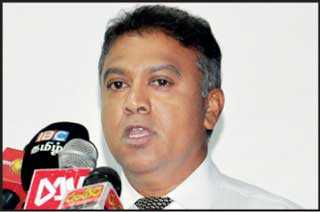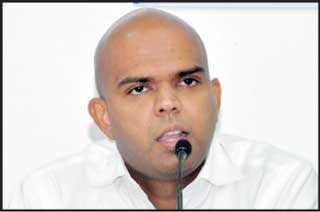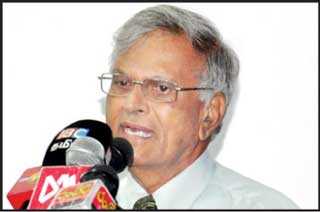Monday Dec 08, 2025
Monday Dec 08, 2025
Friday, 10 July 2020 00:00 - - {{hitsCtrl.values.hits}}
By Shailendree
Wickrama Adittiya
The Solar Industries Association (SIA) yesterday called for an increase in Government support for solar power projects, to align with policy on increasing renewable energy generation to account for 80% of
 |
Solar Industries Association Sri Lanka Secretary Lakmal Fernando |
 |
Solar Industries Association Sri Lanka President Kushan Jayasuriya |
 |
Solar Industries Association Sri Lanka Vice President Prakrama Jayasinghe |
total generation by 2030.
“Today, we are not allowed to connect a single megawatt of solar power nor a single megawatt of wind power without calling for tenders. An 80 MW mini-hydro plant was halted for five years, and only 32 MW was passed recently. However, without any tender procedure, 300 MW of coal power is being purchased,” SIA Secretary Lakmal Fernando told journalists yesterday.
He explained that there were also discussions on reducing the tariff on rooftop solar systems. At present, the energy cost of rooftop solar is 19.80 LKR/kWhm, which means that the Ceylon Electricity Board (CEB) spends Rs. 19.80 per unit to buy rooftop solar power from Sri Lankan citizens.
“An issue the industry is facing is that, after General Elections, they are attempting to remove this 19.80 LKR/kWh. As soon as it is removed, they can purchase 100 MW of emergency power,” Fernando added.
According to the SIA, when capital cost is taken into consideration, coal-fired power has an energy cost of 22.50 LKR/kWh and oil-fired has an energy cost of 39.62 LKR/kWh. Ground-mounted solar is 19.56 LKR/kWh.
By 2027, they estimate that rooftop solar will reduce to 15.50 LKR/kWh, ground-mounted solar will remain at 19.56 LKR/kWh, while coal-fired will increase to 27.17 LKR/kWh and oil-fired will increase to 46.02 LKR/kWh.
“We still do not know how much we need to pay per unit, but we can make assumptions based on calculations about today’s pricing,” Fernando said.
The SIA also shared data on foreign exchange saving by substituting oil-fired with rooftop solar, which showed a Rs. 6.3 billion or $ 34 million foreign exchange saving in 2020. This includes only operational costs, and capital costs have not been taken into consideration when making the calculations.
Fernando went on to say that there are two ways in which rooftop solar projects can be halted after the General Elections. Firstly, regulations can be implemented to prevent solar power from being added to the national supply, and secondly, the tariff can be reduced to 15 LKR/kWh, making it financially difficult to afford rooftop solar.
He added that, while the Power and Energy Ministry opposes such limitations on the rooftop solar industry, there are officials in favour of it.
“We have reason to believe a group of officials supporting the diesel and coal mafia are attempting a conspiracy to disrupt local entrepreneurship in the solar industry, and to change the Government policy in a subtle way, so that they can bring in long-term emergency power at a huge cost to the country,” SIA explained in a statement issued yesterday.
They added that the solar rooftop industry has created 25,000 local entrepreneurs and 10,000 job opportunities so far.
The SIA also spoke about the role played by solar power to reach the goal of renewable energy, accounting for 80% of total power generation by 2030. “The President has a concept of increasing renewable energy to 80% of the total generation. While there are various ways of achieving this, we would like solar power to be given prominence. As of now, without any Government investment, we are generating 270 MW through solar power,” SIA President Kushan Jayasuriya said.
According to data shared by SIA, solar power can contribute 5 GW by 2030. Of this, 2 GW will be through rooftop solar, and 3 GW will be through a combination of ground-mounted and floating solar.
The SIA stated that, at present, 25,000 solar systems supply 270 MW to the national grid. However, to reach the goal of 2 GW through rooftop solar, at least 200,000 systems will be required.
“There are close to 6.5 million electricity accounts in Sri Lanka. Without apartments, we can say there are 5.5 million rooftops and of this, if we can convert 1 million to solar power projects, with a minimum of 3 KW per system, we can install 3 GW of solar panels on these rooftops,” Fernando explained.
He added that studies show there is enough barren land in Sri Lanka to install ground-mounted solar of a 20 GW capacity, while there is enough surface area on bodies of water for 35 GW of floating solar.
In a statement, SIA said, “Only 270 MW of roof-mounted solar systems and 62 MW of ground-mounted systems have been added to the national grid from 2016 to date. Growth at this slow pace will not be sufficient to meet the target set for 2030. Therefore, capacity addition to the grid from solar power should be increased to 200 MW annually starting from 2021.”